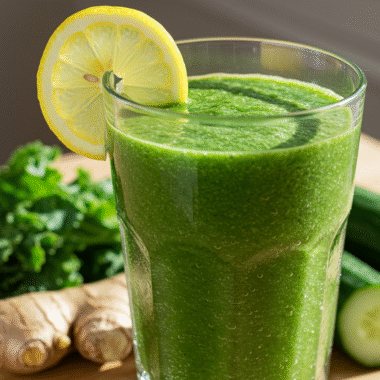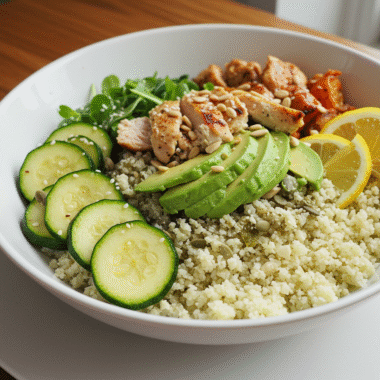When my body feels out of rhythm—maybe I’ve tasted too many test batches or simply need a pause—I go straight to peppermint tea. It’s not a gimmick, and it’s not trendy. It’s a minty reset I’ve returned to time and time again, both in my kitchen and in my own self-care rituals
If you’re looking for something that calms the belly, lifts brain fog, and gently nudges your body toward balance, you’re in the right place. Peppermint tea is more than a cozy drink—it’s a wellness tool. In this guide, I’ll walk you through exactly how I’ve used peppermint tea in my day-to-day life, the science that backs it, and why you might want to add it to your own routine.
Whether you’re dealing with bloat, cravings, or just need a fresh start—peppermint tea can be your quiet fix. And if you’re already in love with teas like Dandelion Root Detox Tea, this will be a natural fit for you.
Check out our full list of weight loss soups for more light and nourishing bowls.
Table of Contents
What Is Peppermint Tea?
What is peppermint tea made from?
Here’s the thing about peppermint tea—it’s simple, and that’s what makes it powerful. It’s made by steeping either fresh or dried peppermint leaves in hot water. That’s it. No additives, no strange powders—just nature doing what it does best.
Peppermint, a cross between spearmint and watermint, is rich in menthol—that’s the compound that gives it that cool, tingly sensation you feel the moment it hits your tongue. In the kitchen, I always keep a jar of dried peppermint leaves tucked in the same drawer as my go-to spices. Why? Because it’s one of those ingredients that works just as hard for your health as it does for your tastebuds.
When I’ve had a long day tasting heavier foods, peppermint tea helps soothe the chaos in my stomach. It’s caffeine-free, too, so I often sip it late in the evening while I’m jotting down notes for new recipes.
How does peppermint tea differ from other herbal teas?
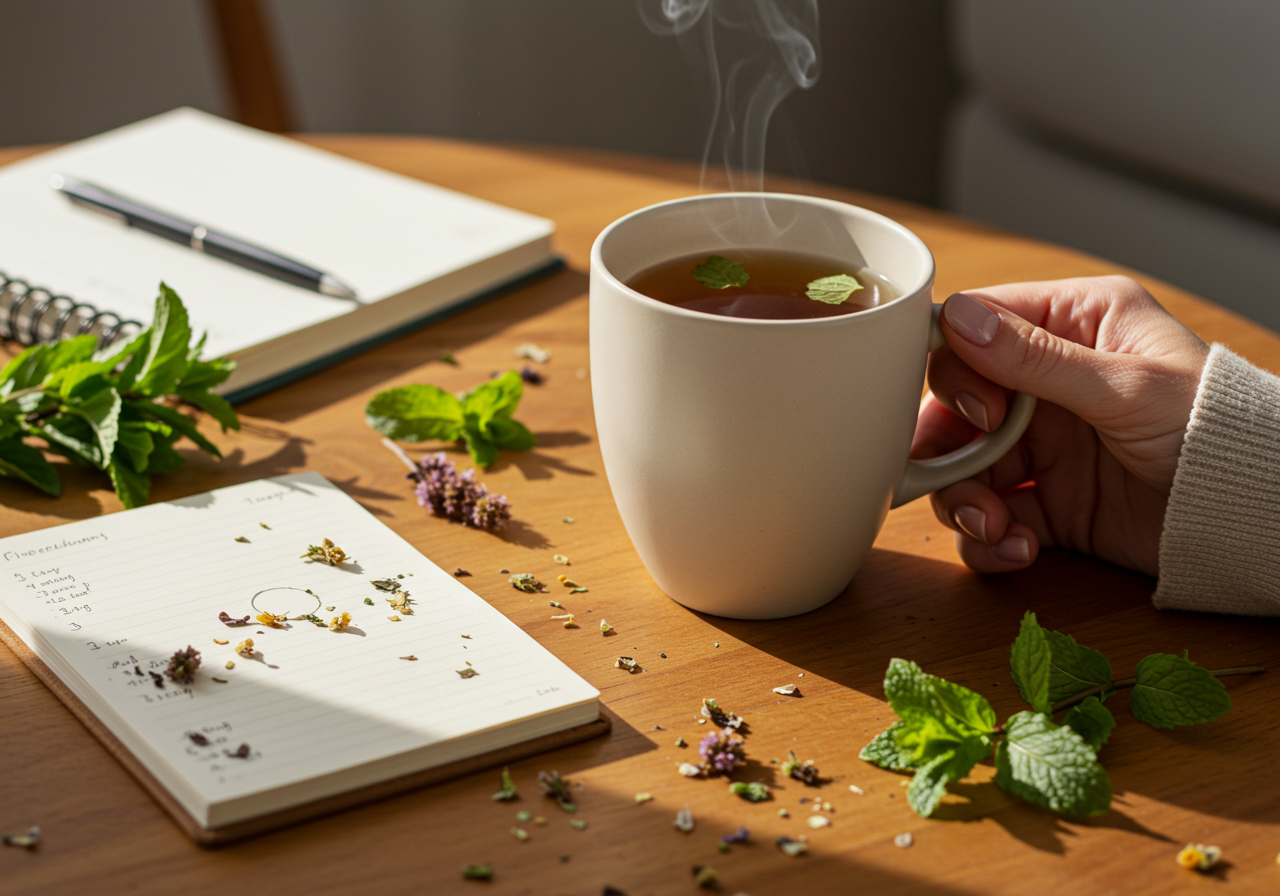
Peppermint Ginger Gut-Soother
Ingredients
Equipment
Method
- Place dried peppermint and sliced ginger into your mug or infuser.
- Pour hot water over the herbs, cover, and let steep for 8–10 minutes.
- Strain the tea, add honey or lemon if desired, and sip slowly.

Nutrition
Video
Notes
Let’s be honest—there are a lot of herbal teas out there promising the moon. But peppermint tea? It delivers.
It shines brightest when it comes to digestion and bloat relief. While chamomile relaxes the mind and ginger kicks inflammation to the curb, peppermint takes care of your gut like a backstage crew—you don’t always notice it working, but the show runs smoother because of it.
Here’s a quick comparison I use when clients ask what tea to keep on hand:
| Feature | Peppermint Tea | Chamomile Tea | Green Tea |
|---|---|---|---|
| Caffeine-Free | Yes | Yes | No |
| Digestive Support | Excellent | Gentle | Mild |
| Menthol Power | High | None | None |
| Calming Effect | Yes | Yes | No |
| Best Time to Drink | After meals, before bed | Evening | Morning |
And one of my favorite combos? A peppermint and parsley detox blend. I created a recipe for it recently—don’t miss our Mint Parsley Detox Tea with Honey if you want a cooling, cleansing twist on your classic cup.
Back in culinary school, we were taught that every ingredient should serve a purpose. Peppermint tea does just that—it soothes, it strengthens, and it does it without any noise.
Health Benefits of Peppermint Tea
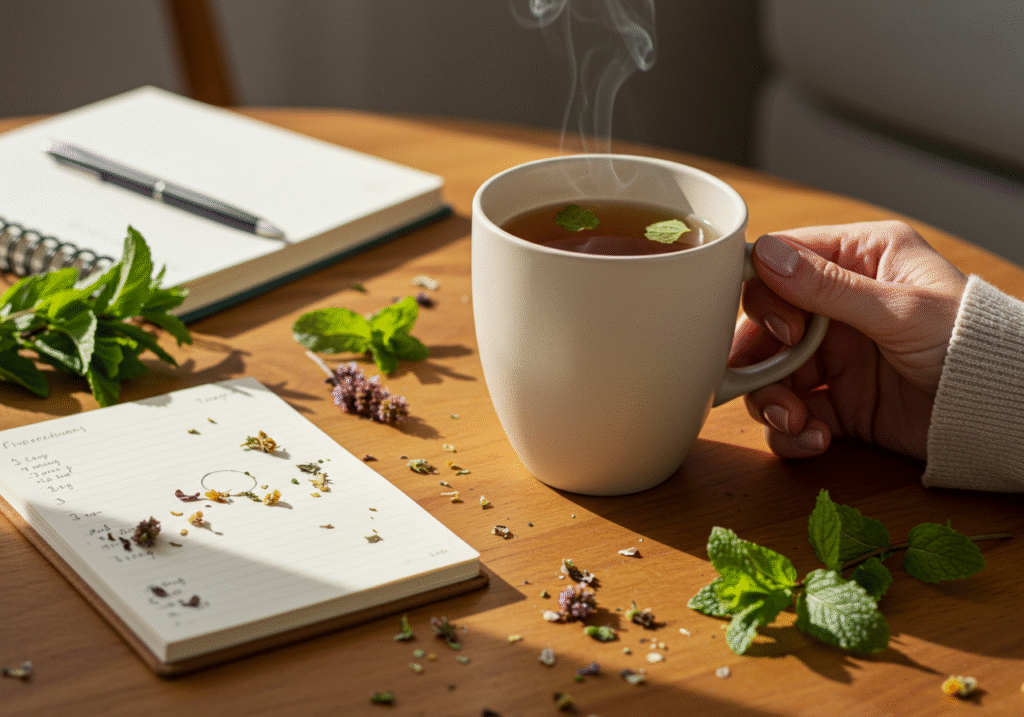
Why peppermint tea is good for digestion
Let me tell you something I’ve seen happen time and time again—with myself and with clients: a bloated belly, sluggish digestion, or that too-full feeling after one too many bites can be completely turned around by a single, well-steeped cup of peppermint tea.
This isn’t just a kitchen myth. The menthol in peppermint helps relax the smooth muscles in your digestive tract. That means less cramping, less bloating, and a whole lot more ease after eating. For me, peppermint tea is my go-to digestive support after big recipe test days. You know those moments where you’re tasting soups, then smoothies, then maybe a bit of dessert? My belly’s confused—and peppermint tea sets it straight.
If you’re someone who deals with indigestion, acid reflux, or IBS-like symptoms, peppermint tea might become your new best friend. I’ve seen people reduce their reliance on over-the-counter gas relief meds just by drinking this tea consistently after meals.
Quick tip from the kitchen: steep your tea for 7–10 minutes, cover the cup while it brews, and drink it warm—not scalding—for best digestive support.
How peppermint tea supports mental clarity and focus
There’s a reason I keep peppermint in my apron pocket during long cooking sessions. That fresh scent? It doesn’t just wake up the palate—it wakes up the mind.
Studies have shown that peppermint aroma can improve alertness, memory, and focus. And while that’s great news, I’ll tell you what’s even better: sipping the tea gives you all that, plus hydration, plus gut support.
When I’m prepping for long recipe shoots or days full of creative writing, peppermint tea helps me stay sharp without the caffeine crash. It gives me energy—not the wired, jittery kind, but the calm, steady clarity that helps me get in the flow.
Whether you’re writing, meal prepping, or chasing after kids, peppermint tea offers the kind of support that starts small but adds up. It’s a mental reset in a cup.
Want an extra brain-boosting blend? Add a few rosemary sprigs or a touch of matcha for an afternoon pick-me-up without the buzz.
And while we’re here—learn more about Cauliflower Turmeric Weight Loss Soup for a meal that pairs beautifully with peppermint tea for gut-friendly balance.
Peppermint Tea for Detoxification and Bloating

Does peppermint tea flush out toxins?
Let’s clear something up. When people ask me, “Does peppermint tea detox the body?”—they’re usually thinking of dramatic juice cleanses or quick-fix teas that promise to reset your whole system overnight.
That’s not how real food—or real wellness—works.
What peppermint tea does is much more subtle and sustainable. It supports your body’s natural detox processes, rather than hijacking them.
In my own life, especially after a week of heavy development cooking, I drink peppermint tea to give my liver and gut the tools they need to function smoothly. Peppermint stimulates bile flow, which helps your body break down fats and eliminate waste efficiently. Think of it as giving your digestive system a soft nudge in the right direction, rather than a shove off the cliff.
It’s also naturally anti-microbial and anti-inflammatory, which makes it useful for calming the internal chaos that often follows overly processed meals or stress-heavy days.
My go-to reset? A cup of peppermint tea in the evening, followed by a 10-minute walk and a light, brothy dinner. Works every time.
Natural cleansing properties of peppermint oil and leaves
Now, let’s talk about why peppermint tea actually works. The magic is in the plant—more specifically, the oils inside the leaves.
The menthol and rosmarinic acid in peppermint help calm inflammation, relax tight muscles in the gut, and may even help the body naturally eliminate toxins through better bowel movements. I’ve seen it firsthand with clients who struggle with sluggish digestion, water retention, or bloating after travel.
Here’s how I usually explain it to clients: Peppermint tea doesn’t “cleanse” in the way laxative teas do. It’s not a quick burn. It’s a gentle flush, led by hydration, better digestion, and improved liver flow.
Want to amplify the detox power? Combine peppermint tea with a slice of lemon and a few cucumber slices. It’s like a spa day for your insides.
For more inspiration, discover great ideas like Healthy Ideas on how to support your body naturally—without extremes.
Peppermint Tea and Illness Relief
What illness can peppermint treat?
Let me start with a truth I’ve seen over and over again: when someone in my house is under the weather—runny nose, sore throat, or just plain “off”—I don’t reach for the medicine cabinet right away. I head to the herb drawer, boil water, and reach for peppermint.
Peppermint tea isn’t just soothing—it’s legitimately therapeutic. Thanks to its antimicrobial and antiviral properties, it’s often my first step in fighting off colds, calming coughs, and easing sinus pressure.
- Got a sore throat? The menthol in peppermint tea helps numb and cool the throat.
- Fighting a fever? Peppermint’s natural cooling effect can help regulate body temperature.
- Nausea or stomach flu? A warm cup settles the stomach faster than most over-the-counter options.
One client of mine, a food stylist always on her feet, swears by peppermint tea with a touch of honey and lemon at the first sign of a head cold. She says it keeps her productive and feeling in control—even when she’s under the weather.
Scientific support for peppermint’s antimicrobial effects
Now, I’m a chef—not a doctor. But I’m also someone who believes in reading the labels, checking the research, and paying attention to what actually works in real life. And science has plenty to say about peppermint’s potential.
Clinical research shows that peppermint contains menthol, limonene, and flavonoids—compounds known for their:
- Antibacterial and antiviral effects
- Pain-relieving properties
- Muscle-relaxing activity (especially in the gut)
A study published in Phytotherapy Research found that peppermint oil, used in teas and tinctures, may help reduce symptoms of irritable bowel syndrome, including pain, bloating, and even loose stools. That’s not just folk wisdom—it’s data-backed.
But here’s the key: use it consistently, and use it with purpose. Don’t expect peppermint tea to “cure” a virus—but do expect it to support your body’s healing process, gently and reliably.
My healing ritual: I sip peppermint tea with raw honey and fresh ginger anytime a cold tries to sneak in. It opens the sinuses, soothes the chest, and warms the whole body from the inside out.
Looking for inspiration? Try Mint Parsley Detox Tea with Honey for a flavorful boost when you’re feeling run down.
Is There a Downside to Peppermint Tea?
Is there a downside to peppermint tea?
As much as I love peppermint tea—and believe me, I really love it—I always remind my clients (and myself): no one ingredient is a fix-all. Even the most healing plants can have their limits.
While peppermint tea is gentle for most people, there are a few situations where you’ll want to sip with caution. I learned this firsthand when a student in one of my detox workshops started drinking three cups a day—and suddenly found herself dealing with unexpected reflux.
Here’s the truth: peppermint tea relaxes the muscles of your digestive tract, which is great for easing cramps or bloating. But it can also relax the lower esophageal sphincter—a fancy term for the muscle that keeps stomach acid from rising into your throat. For people who suffer from GERD or acid reflux, this can make symptoms worse.
My kitchen rule: if peppermint tea gives you heartburn, back off and try ginger or fennel instead. Listen to your body—it always tells you what it needs.
Who should avoid peppermint tea and why
Let’s talk specifics. Peppermint tea isn’t ideal for:
- People with acid reflux or GERD
As mentioned, it may relax the wrong muscles and worsen symptoms. - Infants and very young children
Peppermint oil in strong forms can cause breathing issues in babies. For them, stick to safer, milder herbs like chamomile—always with pediatrician approval. - People with peppermint allergies (rare but real)
If you notice itching, swelling, or shortness of breath after drinking peppermint tea, discontinue use and consult a doctor. - Those taking certain medications
Peppermint may interact with medications like cyclosporine or antacids. Always ask your provider before adding herbal teas to your daily routine.
Pro tip: Want something cooling without the reflux risk? Try iced cucumber mint water with a splash of lemon. Still refreshing, but gentler on the stomach.
And here’s the thing—I’m not telling you to fear peppermint tea. I drink it almost daily. But in the same way I wouldn’t eat five bowls of soup in one sitting, I wouldn’t recommend drinking it by the quart without understanding how it fits into your bigger wellness picture.
Peppermint Tea vs Other Herbal Detox Teas
Comparing peppermint tea to dandelion and mint-parsley detox teas
If you’ve ever stood in your kitchen wondering, Should I go with peppermint today—or try that dandelion root tea?—you’re not alone. I get this question often from clients and readers who are trying to build a better, bloat-fighting tea routine.
Here’s my take after testing dozens of detox recipes over the years: each tea has its own lane, and peppermint’s is digestion, clarity, and bloat relief.
Let’s break it down:
| Tea Type | Key Benefit | When I Use It |
|---|---|---|
| Peppermint | Soothes bloating, supports digestion, improves focus | After meals or on sluggish days |
| Dandelion Root | Liver support, diuretic, helps with water weight | Morning cleanse or after indulgence |
| Mint-Parsley with Honey | Combines peppermint’s gut relief with parsley’s anti-bloat minerals | Midday or pre-meal reset |
I created a blend with both mint and parsley for a reason—they complement each other perfectly. The parsley adds potassium and helps flush excess sodium, while the peppermint keeps your gut calm and happy.
Don’t miss our popular recipe: Mint Parsley Detox Tea with Honey—it’s a crowd favorite for a reason.
Which herbal teas pair well with peppermint for added benefits?
In my kitchen, teas are rarely just one-note. I like to layer herbs the way I layer flavors in a salad or a sauce. Peppermint is the perfect base—it’s light, cool, and blends well with others.
Here are some of my go-to pairings:
- Peppermint + Ginger
A power combo for digestion and inflammation. I use this after heavy meals or long tasting days. - Peppermint + Lemon Balm
For anxiety, sleep, and calm evenings. This one’s gentle and a great bedtime ritual. - Peppermint + Fennel
A true gut reset. Great for gas, bloating, and that “too full” feeling after social weekends. - Peppermint + Dandelion + Lemon
My ultimate deep-clean blend—hydrating, alkalizing, and liver-loving.
Chef tip: Always steep covered, especially when using herbs like peppermint or lemon balm. The oils are volatile, and you don’t want them escaping with the steam!
Bottom line? Don’t think of peppermint tea as a solo act. It shines brightest when it’s part of a well-built, intentional tea blend that speaks to what your body needs that day.
How to Brew Peppermint Tea for Maximum Benefits
Best brewing methods: fresh vs dried leaves
Let’s clear this up—both fresh and dried peppermint leaves work beautifully, but there’s a slight difference in flavor and potency. I keep both on hand. When my garden’s full, I clip fresh peppermint leaves right before brewing. But in cooler months or busy weeks, I reach for the dried stash I keep sealed in a glass jar near my spices.
Here’s how I brew each:
For fresh peppermint:
- Rinse a handful (8–10 leaves) of fresh peppermint
- Lightly crush them to release the oils
- Pour 8–10 oz of just-boiled water over them
- Cover the cup or teapot (this traps in the essential oils!)
- Steep for 8–10 minutes
- Strain and enjoy
For dried peppermint:
- Use 1 heaping teaspoon of dried leaves
- Pour over 8–10 oz of just-boiled water
- Cover and steep for 5–7 minutes
- Strain and sip
Chef’s note: Don’t rush the steeping process. You’re not just making a warm drink—you’re extracting volatile oils like menthol and rosmarinic acid that make peppermint tea so powerful.
Should you drink peppermint tea hot or cold?
Honestly? Both have their moment. It depends on your goal and your mood.
Hot peppermint tea
Best for digestion, calming the nerves, easing sinus congestion, or winding down at night. I usually reach for a hot mug after dinner or during recipe development days when my gut’s working overtime.
Iced peppermint tea
Perfect for warm weather hydration, detox flushes, and mid-afternoon pick-me-ups. In the summer, I brew it hot, let it cool, then chill with lemon slices, cucumber, or fresh mint for a super-refreshing drink.
Here’s one of my favorite summer brews:
Cucumber Lemon Mint Cooler
- 2 cups brewed peppermint tea (cooled)
- 3 cucumber slices
- 2 lemon wedges
- Ice + splash of apple cider vinegar (optional but amazing)
Want to level it up? Add a pinch of sea salt and maple syrup for a natural electrolyte balance.
When and How Often Should You Drink Peppermint Tea?
Ideal time to drink peppermint tea for health benefits
Timing is everything—especially when it comes to food and wellness rituals. I’ve seen firsthand how just shifting when you drink something can totally change how it feels in your body.
Here’s when I reach for peppermint tea and why:
After Meals
This is my favorite time to sip. Peppermint relaxes the digestive tract, which makes it perfect for easing post-meal bloating, cramps, or heaviness. I especially recommend this if your meal was rich, heavy, or included dairy or grains.
Mid-Afternoon Slump
You know that fog that hits around 3 PM? Instead of pouring another cup of coffee (which can mess with sleep), I go for peppermint tea. It gives me a gentle mental lift—sharpens focus without the crash.
Evening Wind-Down
Because peppermint is naturally caffeine-free and calming, it’s perfect for those post-dinner hours. I’ll often sip it while I’m reviewing client recipes or planning content for the week. It helps signal to my body: it’s time to start slowing down.
Bonus: Peppermint tea also freshens your breath after dinner. No mouthwash needed!
How often is safe to consume peppermint tea daily?
Now let’s talk quantity—because too much of even a good thing can throw things off.
I generally recommend 1 to 3 cups per day for most people. Here’s how I like to structure it:
- 1 cup after lunch (digestion support)
- 1 cup in the late afternoon (mental clarity)
- Optional 1 cup before bed (calm + gut ease)
This rhythm works beautifully for most bodies. But like anything in the kitchen—or in life—it’s about balance. I always tell clients to listen to their bodies. If you notice any reflux or sensitivity, simply cut back or switch to another herbal tea like lemon balm or ginger for a few days.
And remember: peppermint tea works best when it’s part of a consistent wellness practice—not just a one-time fix. Think of it like seasoning in a dish. It’s not the whole recipe—but it brings everything together beautifully.
Looking for a gentle detox meal to pair with your tea? Check out Dandelion Root Detox Tea Recipe for a liver-loving companion.
Recipes and Variations Using Peppermint Tea
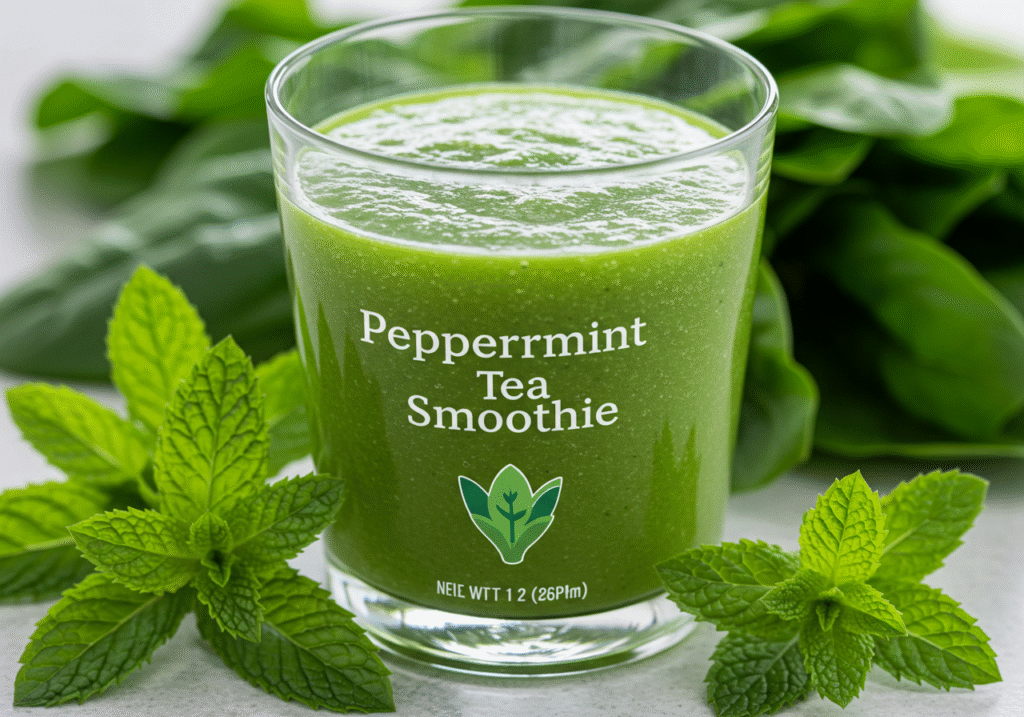
Simple recipes: Peppermint ginger tea, lemon-peppermint detox
I’ve said it before—peppermint tea is powerful on its own. But when you blend it with the right ingredients? That’s when the magic really starts.
Here are two of my most-loved combos, straight from my own mug:
Peppermint Ginger Gut-Soother
Perfect after a rich meal or when your stomach just feels “off.”
Ingredients:
- 1 tsp dried peppermint leaves
- 4 thin slices fresh ginger
- 8 oz hot water
- Optional: squeeze of honey or lemon
Instructions:
Steep both peppermint and ginger together, covered, for 8–10 minutes. Strain, sweeten if desired, and sip slowly. The cooling + warming combo is incredible.
Chef’s note: This one’s also great iced if you’re feeling warm or post-workout bloaty.
Lemon-Peppermint Morning Detox
My go-to when I wake up feeling puffy, heavy, or after too many taste tests the night before.
Ingredients:
- 1 tsp dried peppermint (or 10 fresh leaves)
- Juice of ½ lemon
- 1 slice fresh cucumber
- 1 dash cayenne (optional for metabolism boost)
- 10 oz hot water
Instructions:
Steep the peppermint first. Once brewed, add lemon juice, cucumber, and cayenne. Stir and drink warm before breakfast.
This combo wakes up digestion, encourages detox, and helps set your gut up for a smoother day.
Creative uses: Iced peppermint infusions and smoothies
Don’t think peppermint tea is limited to teacups. I use it as a base for smoothies, iced blends, and even popsicles—especially in warmer months.
Peppermint Tea Green Smoothie
I developed this one for a client who wanted hydration + digestion support in one blend.
Ingredients:
- 1 cup brewed peppermint tea, cooled
- ½ frozen banana
- 1 handful spinach
- 1 scoop collagen or protein (optional)
- 1 tsp chia seeds
- Ice as needed
Instructions:
Blend everything until smooth. Refreshing, gut-soothing, and totally energizing.
Iced Peppermint Citrus Cooler
This one’s for summer afternoons or post-yoga sips.
Ingredients:
- 1 cup brewed peppermint tea, chilled
- 1 orange slice
- Juice of ¼ lime
- 4–5 mint leaves
- Sparkling water (to top off)
Serve over ice with a metal straw. Hydrating, naturally sweet, and way more satisfying than any store-bought “cleanse” drink.
What is peppermint tea good for?
Peppermint tea is one of those gentle powerhouses. I use it for digestive support, bloat relief, mental clarity, and even for natural stress reduction. It’s naturally caffeine-free, so it fits into any time of day. Whether you’re dealing with a heavy meal aftermath or just need to calm the body and mind, peppermint tea is a simple, natural go-to.
Does peppermint tea flush out toxins?
It’s not a “detox bomb,” but yes—peppermint tea gently supports the body’s natural detox process. It helps stimulate bile production, keeps digestion moving, and relieves bloating, which are all part of how your body clears out what it doesn’t need. I always pair it with lemon or parsley for an added cleansing effect.
What illness can peppermint treat?
While peppermint tea isn’t a cure-all, it can soothe symptoms of several common issues:
Colds and flu: Menthol eases congestion and soothes sore throats.
Digestive distress: Great for nausea, cramps, and IBS-like symptoms.
Headaches: That cool aroma actually helps some folks reduce tension.
It’s like your herbal first-aid kit—one cup at a time.
Is there a downside to peppermint tea?
If you deal with acid reflux or GERD, peppermint tea might make things worse by relaxing the muscle that keeps stomach acid down. I’ve also seen rare cases of peppermint sensitivity, so it’s always best to start slow and notice how your body reacts. And if you’re on medication or pregnant? Always check with your provider first.
Want more healthy recipes and fat-burning meal ideas? Follow me on Pinterest at Sarah Weight Loss Ideas
